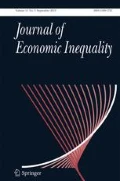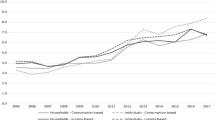Abstract
Tracking poverty is predicated on the availability of comparable consumption data and reliable price deflators. However, regular series of strictly comparable data are only rarely available. Price deflators are also often missing or disputed. In response, poverty prediction methods that track consumption correlates as opposed to consumption itself have been developed. These methods typically assume that the estimated relation between consumption and its predictors is stable over time—assumptions that cannot usually be tested directly. This study analyzes the performance of poverty prediction models based on small area estimation (SAE) techniques. Predicted poverty estimates are compared with directly observed levels in two country settings where data comparability over time is not a problem. Prediction models that employ either non-staple food or non-food expenditures or a full set of assets as predictors are found to yield poverty estimates that match observed poverty well. This offers some support to the use of such methods to approximate the evolution of poverty. Two further country examples illustrate how an application of the method employing models based on household assets can help to adjudicate between alternative price deflators.
Similar content being viewed by others
References
Agarwal, N., Dollar, D., Glewwe, P. (eds): Economic Growth, Poverty and Household Welfare in Vietnam. World Bank, Washington DC (2004)
Azzarri, C., Carletto, G., Davis, B., Zezza, A.: Monitoring poverty without consumption data: an application using the Albania panel survey. East. Eur. Econ. 44(1), 59–82 (2006)
Beegle, K., De Weerdt, J., Friedman, J., Gibson, J.: Methods of household consumption measurement through surveys: experimental results from Tanzania. Policy Research Working Paper Series, 5101. World Bank, Washington DC (2010)
Deaton, A.: Adjusted Indian poverty estimates for 1999–2000. Econ. Polit. Wkly 25, 322–326 (2003)
Deaton, A.: Price trends in India and their implications for measuring poverty. Econ. Polit. Wkly 7, 3729–3748 (2008)
Deaton, A., Zaidi, S.: Guidelines for constructing consumption aggregates for welfare analysis. Living Standards Measurement Study Working Paper 135. World Bank, Washington DC (2002)
Deaton, A., Kozel, V.: Data and dogma: the great Indian poverty debate. World Bank Res. Obs. 20(2), 177–199 (2005)
Demombynes, G., Elbers, C., Lanjouw, J., Lanjouw, P.: How good a map? Putting small area estimation to the test. Revista Internazionale di Scienze Sociali 4, 465–493 (2008)
Elbers C., Pouw, N.: Modelling sequencing patterns in asset acquisition: the case of smallholder farmers in three rural districts of Uganda, mimeo. Amsterdam Institute of International Development (2009)
Elbers, C., Lanjouw, J.O., Lanjouw, P.: Micro-level estimation of welfare. Policy Research Working Paper 2911. World Bank, Washington DC (2002)
Elbers, C., Lanjouw, J.O., Lanjouw, P.: Micro-level estimation of poverty and inequality. Econometrica 71(1), 355–364 (2003)
Elbers, C., Lanjouw, P., Leite, P.: Brazil within Brazil: testing the poverty map methodology in minas Gerais. World Bank Policy Research Working Paper 4513. World Bank, Washington DC (2008)
Filmer, D., Scott, K.: Assessing asset indices. World Bank Policy Research Working Paper 4605. Washington DC, World Bank (2008)
Gibson, J., Huang, J., Rozelle, S.: Improving estimates of inequality and poverty from Urban China’s household income and expenditure survey. Rev. Income Wealth 49(1), 53–68 (2003)
Gibson, J., Stillman, S., Le, T.: CPI bias and real living standards in Russia during the transition. J. Dev. Econ. 87(1), 140–160 (2008)
Grimm, M., Günther, I.: Growth and poverty in Burkina Faso – a reassessment of the paradox. J. Afr. Econ. 16(1), 70–101 (2006)
Grosse, M., Klasen, S., Spatz, J.: Matching household surveys with DHS data to create nationally representative time series of poverty: an application to Bolivia. Courant Research Centre Discussion Paper 21. Georg-August-Universität Göttingen, Göttingen, Germany (2009)
Harrower, S., Hoddinott, J.: Consumption smoothing in the Zone Lacustre, Mali. J. Afr. Econ. 14(4), 489–519 (2005)
Hoogeveen, J., Ruhinduka, R.: Lost in transition? Income poverty reduction in Tanzania since 2001. Background Paper to the Tanzanian Population and Human Development Report 2009 (2009)
Kijima, Y., Lanjouw, P.: Poverty in India during the 1990s: a regional perspective. Policy Research Department Working Paper 3141. World Bank, Washington DC (2003)
Lanjouw, J.O., Lanjouw, P.: How to compare apples and oranges: poverty measurement based on different definitions of consumption. Rev. Income Wealth 47(1), 25–42 (2001)
Luttmer, E.: Measuring poverty dynamics and inequality in transition economies – disentangling real events from noisy data. World Bank Policy Research Working Paper 2549. World Bank, Washington DC (2001)
Mathiassen, A.: A model based approach for predicting annual poverty rates without expenditure data. J. Econ. Inequal 7(2), 117–135 (2009)
Ravallion, M.: How well can method substitute for data? Five experiments in poverty analysis. World Bank Res. Obs. 11(2), 199–221 (1996)
Sahn, D., Stifel, D.: Poverty comparisons over time and across countries in Africa. World Dev. 28(12), 2123–55 (2000)
Sen, A., Himanshu: Poverty and inequality in India-I. Econ. Polit. Wkly 8, 4247–4263 (2004)
Stifel, D., Christiaensen, L.: Tracking poverty over time in the absence of comparable consumption data. World Bank Econ. Rev. 21(2), 317–341 (2007)
Stillman, S., Thomas, D.: Nutritional status during an economic crisis: evidence from Russia. Econ. J. 118–531, 1385–1417 (2008)
Tarozzi, A.: Calculating comparable statistics from incomparable surveys, with an application to poverty in India. J. Bus. Econ. Stat. 25(3), 314–336 (2007)
Tarozzi, A.: Can census data alone signal heterogeneity in the estimation of poverty maps? J. Dev. Econ. 95(2), 170–185 (2011)
Tarozzi, A., Deaton, A.: Using census and survey data to estimate poverty and inequality for small areas. Rev. Econ. Stat. 91(4), 773–792 (2009)
Wall, M., Johnston, D.: Counting heads or counting televisions: can asset-based measures of welfare assist policy-makers in Russia? J. Hum. Dev. Capabilities 9(1), 131–147 (2008)
World Bank: Kenya poverty and inequality assessment: volume I: synthesis report. Report No. 44190-Ke, Poverty Reduction and Economic Management Unit, Africa Region. World Bank, Washington DC (2008)
Author information
Authors and Affiliations
Corresponding author
Additional information
The paper has benefited from comments by two anonymous referees and participants in the UNU-WIDER “Frontiers of Poverty Analysis” Conference held in Helsinki, 26–27 September, 2008. Part of the study was completed during Luc Christiaensen’s 2-year sabbatical at UNU-WIDER in Helsinki, whose support is gratefully acknowledged. The findings, interpretations, and the findings, interpretations, and conclusions expressed in this paper are entirely those of the authors, They do not necessarily represent the views of the International Bank for Reconstruction and Development/World Bank and its affiliated organizations, or those of the Executive Directors of the World Bank or the governments they represent.
Rights and permissions
About this article
Cite this article
Christiaensen, L., Lanjouw, P., Luoto, J. et al. Small area estimation-based prediction methods to track poverty: validation and applications. J Econ Inequal 10, 267–297 (2012). https://doi.org/10.1007/s10888-011-9209-9
Received:
Accepted:
Published:
Issue Date:
DOI: https://doi.org/10.1007/s10888-011-9209-9




